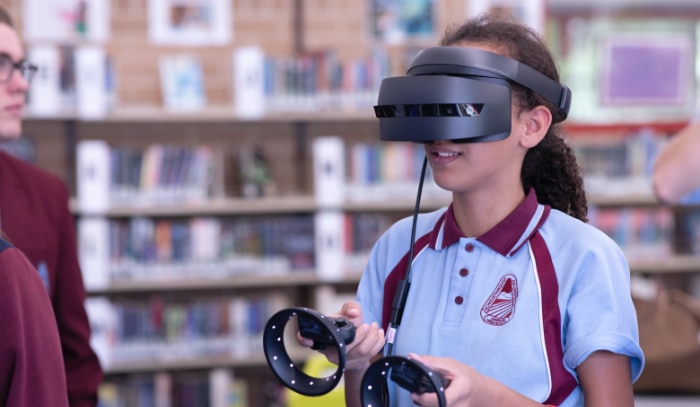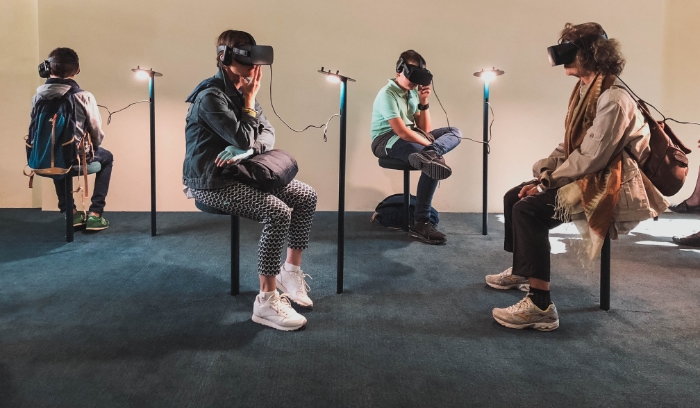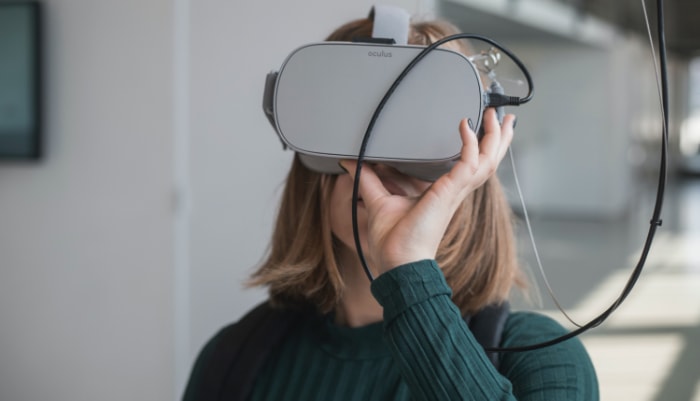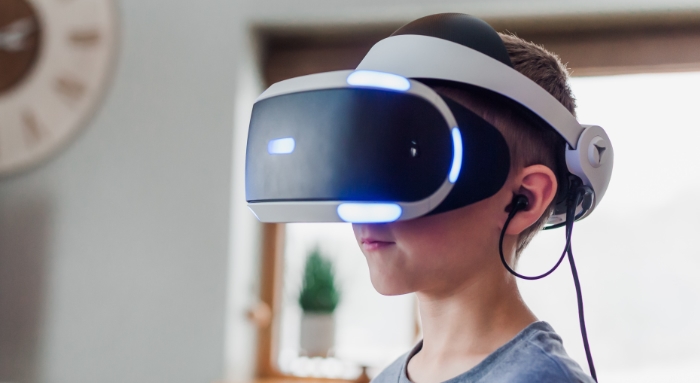Virtual Reality in Education
Education is the bedrock of a functioning society, and civilizations have placed a premium on information transmission from their inception. People are continually seeking methods to improve the effectiveness with which information is transferred.
Humans have always incorporated new technology (to the best of their abilities) into education to enhance their learning.
In today's age, Virtual Reality (VR) appears to be the next logical step in the evolution of our educational system.
This article explores the many layers of this discussion in depth.
Virtual Reality Learning
Before we begin our discussion, it is crucial to understand what VR (Virtual Reality) learning is.
Most people today will have heard of VR. However, only a handful are aware of the many potential uses VR could serve in our education. Still, the use of VR in education is accelerating, with a growing number of institutions embracing technology.
VR is a term that refers to interactive material (pictures or movies) that lets the spectator explore a scene completely in 360 degrees. This technology can enable students to see sites all over the globe (as well as any fictional setting) without ever leaving their classroom.
With VR, students could visit, for instance, the Giza pyramids or the depths of our solar systems while seated at their desks.
The kind of VR that is mostly utilized in education is 360VR. This sort of VR utilizes specialized cameras and technology to record real-world locales. The film is subsequently returned to the studio, where it is converted into virtual reality entertainment.
After that, the VR information may be seen on virtual reality headsets in what we now refer to as “immersive classrooms.”
360° virtual reality may be used to educate students about their environment.
Additionally, virtual reality offers an unmatched capacity for inspiring and engaging pupils. Students may visit areas that would be impractical or too costly to see in reality. Virtual reality may open up a whole new universe of possibilities for educators and schools.
How Can VR Improve Education?
This section will highlight the top ways VR can be expected (and improve) our current methods of seeking education.
Greater Focus On Experiential Knowledge
The most apparent improvement that VR can be expected to bring to our educational system is to provide students with experiential knowledge- a facet of learning that is deeply lacking in our current education model.
Since VR can immerse students into simulations of real-life environments, students can step outside the limited illustrative abilities of school textbooks and learn by actually seeing the objects of their study.
It is near impossible to attain any experiential knowledge with a set of board markers and textbooks, but virtual reality learning will make such learning instantly possible.
Through experiential knowledge, students will better understand what they study as more of their senses will be engaged in their learning. This will directly translate into students retaining the contents of their lectures better.
Inspiration
The human imagination is a powerful tool that allows us to mentally put ourselves in situations that can be quite distant from reality. However, our imaginations do not stimulate our senses as much because we are not convinced that they're real.
VR simulation, however, can come pretty close to representing real-life environments. Since the VR models we see on screen are designed beforehand, they offer us better attention to detail of the virtual settings we are trying to enter.
Since, while using VR, students won't have to use their energy to imagine such places/settings inside their heads, they will be able to focus more on engaging with the content in front of them.
This is bound to result in a better learning experience as students can take inspiration from the depictions of reality; they will see that they otherwise would not be exposed to.
Boosting Creativity
When students are immersed in their learning environments, they will engage with their learning material as they do with the real world around them.
This is bound to enable them to think out of the box and come up with creative solutions to the problems that they encounter in VR settings.
Promotion of Peer Interaction
Something as visually interesting as VR learning is bound to be a popular topic for lunch break conversations. This is because students will be eager to share their thoughts and experiences in those virtual settings.
Students will revisit their lectures through these conversations and hence, learn better and retain more.
Better Engagement; Better Focus
The traditional teaching methods, which use textbooks and long lectures to communicate ideas to students, can get boring pretty quickly. So, it is no surprise that many students zone out into their imaginations while sitting inside their classes.
As we mentioned earlier, VR classes are meant to be much more engaging/and stimulating. This will result in students paying more attention to their classes; hence their focus will improve.
Removes Physical Limitations
The removal of physical limitations poses many benefits to students' learning.
To start with, not being restricted by any such limitations means that students can visit places around the world that would be too dangerous for humans to go to, i.e., on top of a mountain or impossible for humans to go to, i.e., somewhere in the vast expanse of the universe, or would be too costly for students to travel to, i.e., to different countries.
Not being restricted by such limitations means that students will safely be able to gain experiential knowledge of the environments they're trying to study without being exposed to any safety hazards that they might otherwise be prone to.
Greater Inclusivity
As we mentioned earlier, VR learning takes away all forms of physical limitations that might arise from visiting different learning places or going on educational trips.
A direct result of this is that children of less affluent parents would now be able to attend these trips and gain equal learning opportunities.
Better Retention
Since dealing with VR is an enjoyable learning experience, students tend to retain their learning better and eagerly wait for their future lectures.
The Integration of VR in Classrooms
There are two fundamental ways in which VR can be integrated across classrooms:
- Through VR headsets
- Immersive classrooms
In this section, we will discuss both of these methods of integrating VR into classrooms and take a look at how VR can be integrated into classroom settings across different levels of education.
Immersive VR Classrooms – What Are They?
VRclassrooms, or immersive classrooms, are one of the most frequent and successful methods to incorporate VR into education.
Immersive classrooms are classrooms in which pictures are projected into the room's interior walls. As a result, a virtual world is created inside the classroom.
Students may be “teleported” to another location without leaving the classroom.
Without using VR gear, students may participate in the experience collaboratively and thus are encouraged to participate.
Unlike virtual reality headsets, which may be difficult or unpleasant for certain students to wear, immersive classrooms are accessible to all students. Students can nowinteract with the virtual reality information in a much more familiar atmosphere.
VR Headsets in Classrooms
Virtual reality headsets are a popular and practical method of incorporating VR into the classroom. Due to the low cost, minimum equipment, and minimal space requirements, a growing number of colleges are moving to virtual reality headsets.
Usually, approximately fifteen VR headsets are needed for a class of thirty pupils. These are often stand-alone devices, meaning that they do not need any other equipment, such as a computer, to operate. Teachers are instructed on properly utilizing the headsets before incorporating them into a class.
The primary advantage of virtual reality headsets is the degree of immersion they deliver. While they are more challenging to operate than virtual classrooms, they deliver an impressively realistic experience. A memorable event that kids are unlikely to forget anytime soon.
VR for Primary Schools
Virtual reality may be utilized well in elementary education and is becoming more prevalent in the United Kingdom.
Immersive classrooms are more popular in elementary schools than virtual reality headsets. This is because each kid can be supervised effortlessly, and younger pupils do not need instruction on how to use headphones. This guarantees a more seamless and equitable experience for all students.
Pupils are urged to glance around and share their observations. This fosters collaboration among students and may significantly enhance communication among relatively introverted pupils.
VR in Secondary Education
VR headsets are more common in secondary school than in immersive classrooms. This is because VR headsets have a stronger influence on older kids.
With the full field of vision contained, a VR headset provides an unsurpassed level of immersion. Additionally, unlike elementary school students, secondary students are more adept at using the headsets, needing less input and instruction from the instructor.
By using VR headsets, instructors may give secondary pupils the sensation of “being there” — being immersed in the simulations they see. This is a fantastic experience for many students, and the world would do well to catch on to this marvelous new (relatively) method of learning.
How VR Can Help Students With Learning Difficulties
Virtual reality learning may be quite beneficial for those who struggle with studying. Students may understand the reality that surrounds them in a regulated and secure atmosphere.
As with primary school kids, immersive classrooms are the most often used kind of virtual reality to assist pupils with learning disabilities.
It is pretty unusual for pupils to have difficulty using virtual reality headgear.
Teachers may conduct lessons in a much more natural manner in an immersive classroom. Students may still look about and explore their virtual environments, but in a more comfortable manner, without feeling confined.
Virtual reality has been shown to be beneficial for kids with autism. Strickland et al. (2007) demonstrated that children with autism were capable of applying skills learned in a virtual setting compared to the real world.
Virtual Field Trips – Special Emphasis
In this section, we will lay special emphasis on one particular benefit that comes from virtual reality learning, virtual field trips.
Virtual field trips allow students to visit a particular location virtually while remaining inside their classrooms.
This feature opens an innumerable number of doors for students to learn better. Here are some of the major benefits that result from VR-enabled field trips.
Accessibility and Low Cost
Since VR takes away all physical limitations, it makes VR trips a lot more accessible due to two main reasons.
First, because it is far cheaper.
Second, because one does not need to leave their place to go on these trips, no child who is ever hindered by any disability will be refrained from going.
Engagement
Virtual school visits provide a refreshing variation from conventional reading and writing. They may be utilized as a manner of breaking a subject up or bringing in a new one, and they assist in maintaining the students' attention.
What's more, many instructors realize that giving a diversity of teaching approaches is crucial, encouraging pupils to learn in various ways. Not every child learns well with conventional education, and VR provides one additional wonderful means of engaging kids.
Conclusion
VR is bound to become the next step in the evolution of our global educational system.
Where traditional methods of learning and teaching have fallen weak, VR learning picks on to give students an engaging and memorable learning experience that is bound to improve their interest in their studies.
Moreover, we can expect VR classrooms to give students experiential knowledge of the settings/situations that they are studying.
Since VR learning is relatively less costly and breaks past all physical limitations, students will be able to experience learning in settings that are impossible for humans to reach (or to be in safely).
Still, even with all the benefits that VR learning promises for the future of learning, we are a long way from having it fully integrated into our educational sectors.
The cost of these devices, as well as their large-scale manufacturing and distribution, are a few of the many hurdles that we must overcome.






